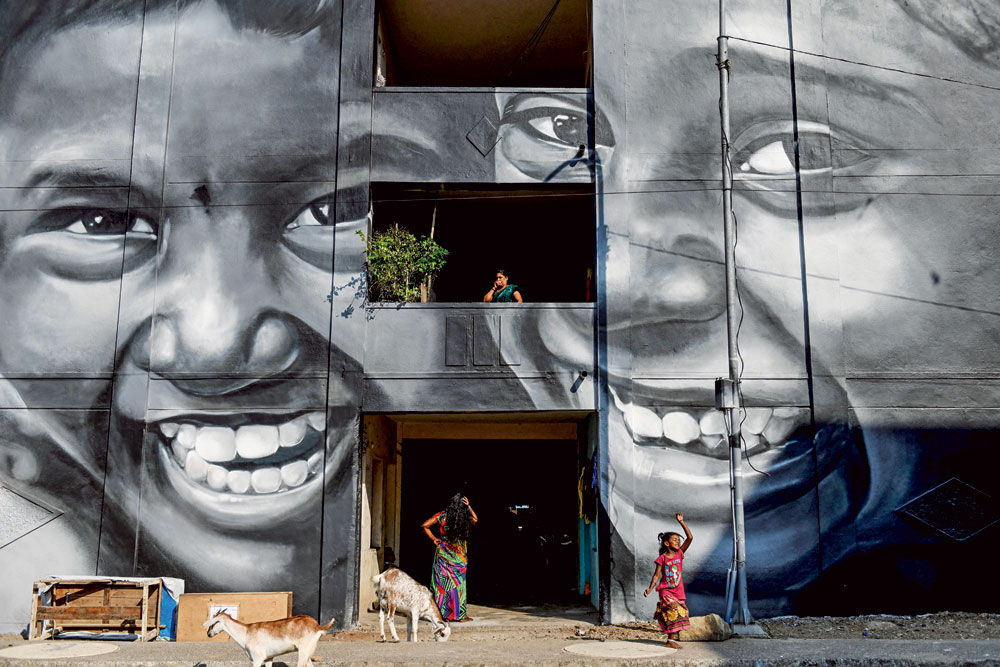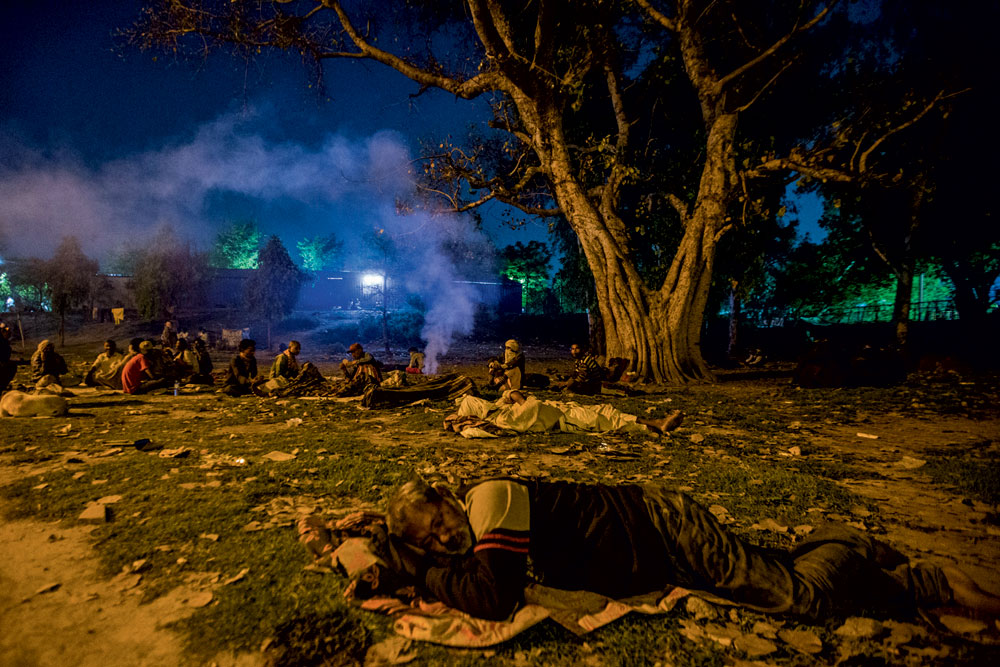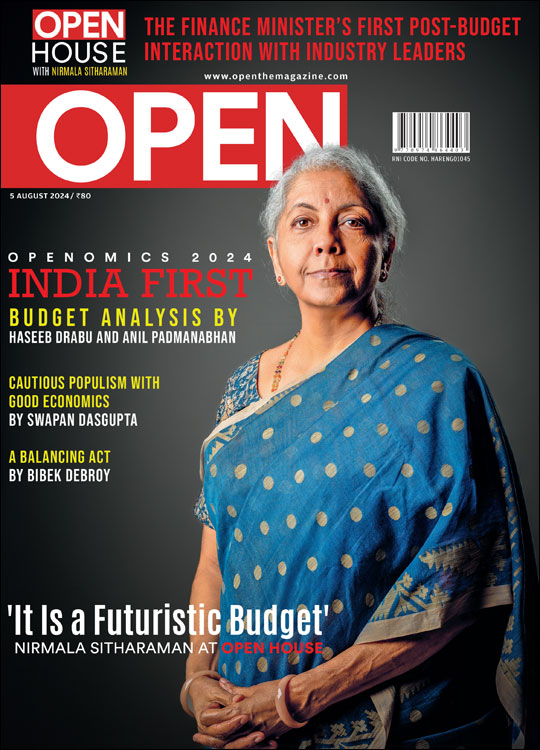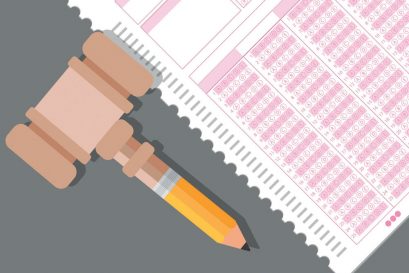Poverty Politics
How the number of the poor is sliding in India
 Siddharth Singh
Siddharth Singh
 Siddharth Singh
Siddharth Singh
 |
22 Apr, 2022
|
22 Apr, 2022

A slum clearance board residential community in Chennai (Photo: AFP)
POVERTY IS A CONTROVERSIAL SUBJECT in India. Any new figures on the extent of poverty lead to instant controversy. The subject is also of some political sensitivity and in the past, electoral campaigns have been crafted around the idea of removing poverty. So, it was not surprising when two working papers from the World Bank and the IMF courted controversy as soon as they were issued.
The controversy is interesting because these are not final, published results. But such is the opprobrium around the idea that poverty could have gone down in recent years that their results were disputed as soon as these papers were issued. These papers are among a series of recent studies evaluating poverty and inequality in recent years. Another paper, issued by the National Bureau of Economic Research (NBER)—a non-profit economics research organisation in the US—looks at trends in inequality during the Covid-19 pandemic.
The World Bank paper, ‘Poverty in India Has Declined over the Last Decade but Not as Much as Previously Thought’, by Sutirtha Sinha and Roy van der Weide, finds that headcount poverty—the percentage of population living below the poverty line—declined by 12.3 percentage points since 2011. In 2019, this figure was 10.9 per cent, down from 22.5 per cent in 2011. Further, the paper found that rural poverty reduced faster—it went down by 14.7 percentage points from 2011 to 2019—than urban poverty. The decrease in urban poverty was comparatively slower at 7.9 percentage points during this time. Rural poverty fell fastest from 2016 to 2017 when it went down from 20 per cent to 14.6 per cent by the author’s estimate. All the poverty figures refer to the internationally accepted poverty line of $1.90 per day.
Interestingly, the paper finds that urban poverty went up by two percentage points in 2016, “coinciding with the demonetisation event.” It also finds that the rate of poverty reduction was noticeably lower during 2015-19 than earlier projections. Poverty reduced by approximately 2.5 percentage points every year from 2004 to 2011; this slowed down to 1.3 percentage points per year during 2011-2018.
The NBER paper—‘Inequality in India Declined During Covid’—by Arpit Gupta, Anup Malani and Bartosz Woda found that inequality fell during the pandemic. The authors say: “Consumption inequality also fell, but to a lesser extent, due to consumption smoothing.”
While poverty attracts public attention to a much greater extent, inequality is also a problem as beyond a certain point, inequality leads to poor growth outcomes. While the authors are careful to say that the pandemic did not cause a reduction in inequality, they note that, “the fact that the Gini Coefficient was the same post-lockdown, suggests that most of the decline in inequality was due to social mobility…it is also likely that labor demand for the occupations the rich occupy fell more than the demand for the services provided by the poor.” The Gini Coefficient is a measure of inequality: 0 being no inequality and 1 being perfect inequality.
Both papers have been criticised on methodological grounds. India follows a complicated process of gathering data and this has been the case since the first sample surveys were started in 1950. Virtually all economic quantities—growth rates, poverty, industrial production and more—are based on estimates as India does not have a robust system of data reporting. There have been changes over time, but surveys remain indispensable for estimating everything.
One such survey is the Consumption Expenditure Survey or CES. This is carried out every five years and forms the basis for estimating poverty. In recent years, there has been a huge controversy over the ‘scrapping’ of the last such survey in 2017-18. Based on a leaked copy of the survey, some authors concluded that poverty had gone up in recent years. But in the absence of a proper CES, scholars have begun using the Consumer Pyramids Household Survey (CPHS). CPHS is also a large survey but it does not approach the depth of coverage of the CES. There is criticism that it is skewed towards better-off respondents, making it less useful for studying poverty and inequality. The authors of the World Bank and NBER papers note these limitations. In fact, much of these papers are about adapting CPHS data to make it somewhat comparable to what CES offers. But this has not been enough to ward off criticism. It is notable that virtually all critics of CPHS data are of a leftist political orientation. CPHS is a product of the private sector economics firm, CMIE.
THESE CONTROVERSIES ARE NOT NEW TO INDIA even as old ones have been forgotten over time. Very often, it is thought that ‘scientific’ measurement of poverty can eliminate errors and controversies alike. History shows that this is an elusive goal. Something eerily similar to what has happened in recent years was witnessed in 2000, almost under exact circumstances.
The National Sample Survey Organisation (NSSO)—now known as the National Statistical Office or NSO—conducts a large CES every five years. It is a huge exercise that involves careful sample design and selection followed by field surveyors fanning out across the country with their questionnaires. In the 1990s, the NSSO experimented with what were known as “thin round” surveys that were carried in between the five-year CES exercise. Round 51 (carried out in 1993-94) and Round 54 (1998) revealed a dramatic reduction in poverty “headcounts”: only half of the standard—large—rounds. What had happened? The story was recounted by Angus Deaton and Valerie Kozel in 2005. Deaton is a globally respected scholar known for his work on survey design as well as an economics Nobel Prize winner.
Some of the quickest rates of reduction in poverty have been observed during the time that India’s economy grew fast. It is not surprising that leftist scholars are deeply sceptical about economic growth
Since the time household surveys began to be conducted in India in late-1950, the standard “recall” or reporting period—the time across which people are asked about their consumption expenditure—was 30 days. In these thin rounds, three different recall periods were experimented with. A seven-day period for items like food, pan and tobacco products, a 365-day period for “low frequency” items like consumer durables, clothing, footwear and expenses on education, among other things, and a 30-day period for everything else.
So, how did poverty ‘reduce’ through these changes? For one, a shorter recall period, seven days instead of 30 days, is likely to lead responders recalling higher expenditure. Higher expenditure, controlling for other things, is likely to lead to lower poverty. This is in the case of expenditures on “high-frequency” items like food. At the same time, if one asks questions about durable goods and other low-frequency purchases during a 30-day recall period, the answer is less likely as compared to a 365-day recall period. A change in recall periods lead to dramatic changes in the scale of poverty.
As now, back then too, this led to seemingly endless controversies. An expert committee was formed to evaluate the “right” recall period. Its deliberations remained inconclusive. Finally, a new round—the Round 55—was launched in 1999-2000 to figure out which reporting/recall period was better: seven days, 30 days or 365 days. It was found that seven-day estimates of consumption were, on average, 23 per cent higher as compared to the 30-day period. Finally, a ‘compromise’ solution was arrived at: all three recall periods for expenditures on different groups of items.
Why should these arcane details of statistical methodology matter? They matter because they give dramatically different measurements of poverty and very different recommendations for ‘fighting’ poverty.
If one looks back at that period, virtually the same controversies have been replicated two decades later. Chief among these is that the last CES, the one in 2017-18, was ‘junked’ and as a result, India does not have accurate poverty figures after 2011. This has led to speculation that poverty has gone up ever since the economy began slowing down from 2019, but has probably accelerated since then due to the pandemic-induced shock. Something similar was said at the end of 1990s, somewhere around 2000: a proper—large—CES had not been conducted since 1993-94 and as a result, there were no estimates of poverty after that date. This was said by Deaton. But unlike the partisan contestants of the poverty numbers game today, Deaton never took sides and patiently explained both sides of the statistical puzzles around the measurement of poverty.
Another contemporary source of anger among economists and data watchers is the alleged lack of transparency on part of the government in sharing data. The same grouse could be heard back then.

Ultimately, these numbers were as politicised then as they are now. Deaton’s words are worth recalling: “Estimated poverty was believed to be too low because reported consumption over the 30-day reporting period had been upwardly biased by the simultaneous presence of the 7-day reporting period.” The key word here is “believed”. The trouble with all these measures is that no amount of data-gathering and refined calculations can change beliefs about poverty. If it is “too low”, then the estimates showing lower poverty headcounts must be wrong. This was true of the controversies around the NSSO rounds in the 1990s and it is equally true of the World Bank working paper that shows a reduction in these numbers.
THERE IS A STRANGE CONTRADICTION AT THE heart of policymaking around poverty in India. Politically, it makes sense to claim victory over poverty if the headcount of poor people goes down. But at the level below political decision-making—at the level of various government departments, ‘experts on poverty’ and those who run anti-poverty programmes—any claim that poverty is going down would be fatal to the boondoggle that has been going on for ages. Every year, a substantial fraction of the Union Budget is spent on welfare measures that include anti-poverty programmes and programmes that are meant to help the poor. Allocations, subsidies and more, everything that goes into ‘reducing poverty’, also entrenches a system that has been around for a long time.
The result is that poverty never really goes away. The controversies around poverty headcounts and the constant claim that poverty lines need to be revised upwards is a byproduct of this system. This is not to say that academic experts are dishonest, but to note a systemic feature.
Ultimately, the contradiction between the political and bureaucratic poles of the system is resolved in favour of continuing with the entire system, from counting the number of the poor to devising anti-poverty policies and more. How does that happen? In India’s noisy democracy, one has to be continuously seen as working for the poor and devising ‘schemes’ for them. Any deviation from the script of ‘working for the poor’ is to call for certain political trouble. It is another matter that poverty is likely to be reduced and the poor actually helped by ensuring higher growth. As the World Bank paper shows, some of the quickest rates of reduction in poverty have been observed during the time that India’s economy grew fast. It is not surprising that leftist scholars are deeply sceptical about economic growth. The choicest epithets are reserved for anyone who makes a case for clearing policy hurdles in the path of higher investment: “neoliberal” and “growthwallah”.
India’s experience in reducing poverty is often contrasted with that of China, which is held to be far more successful than India. But in the vast literature and debates that surround these comparisons, one key element is often ignored: that growth in itself helps. On the one hand, it creates opportunities for the poor that are hard to come by in a slow-growing or sclerotic economy, and on the other hand, it gives the government enough resources to spend on the poor, especially in areas where the private sector is unlikely to chip in. Public health and primary education are two such areas. There are other areas as well, infrastructure being one.
The trend in the third decade of the 21st century is clear: poverty in India is going down even if inequality poses difficult economic and moral choices. The path ahead is equally obvious: instead of creating ever higher poverty lines and inflating the number of poor persons, India will be better off spending more to push economic growth and helping the destitute. It is high time that India abandoned poverty games.














More Columns
Art of Love Nandini Nair
Fruit of the Nation Madhavankutty Pillai
Ladakh: Magic Mountain Abhilasha Ojha